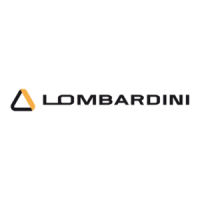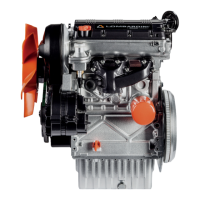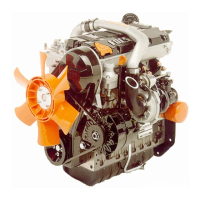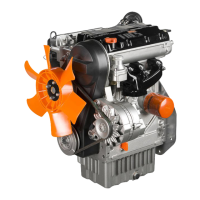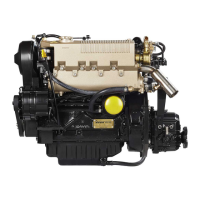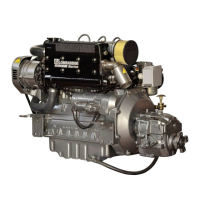
Do you have a question about the Lombardini LDW 2004 and is the answer not in the manual?
| Engine Model | LDW 2004 |
|---|---|
| Category | Diesel Engine |
| Manufacturer | Lombardini |
| Number of Cylinders | 4 |
| Compression Ratio | 22:1 |
| Combustion System | Indirect Injection |
| Aspiration | Naturally Aspirated |
| Fuel System | Mechanical Injection |
| Starting System | Electric |
| Cooling System | Liquid Cooled |
Extraordinary maintenance operations and intervals.
Maintenance tasks to be performed after the first 50 working hours.
Routine checks and inspections for engine components.
Engine oil replacement steps and intervals.
Oil filter replacement steps and intervals.
Fuel filter replacement steps and intervals.
Specifies the engine model and type.
Engine serial number or identification code.
Important notes and guidelines for service operations.
General guidelines for performing service operations.
General information and prerequisites for using the workshop manual.
General notes for service, emphasizing original parts.
General service notes, emphasizing correct part usage.
Critical warnings about immediate risks to persons and property.
Warnings about technical damage to the unit or installation.
Risk of damage to persons and things if instructions are not followed.
Risk of technical damage to the unit or installation if instructions are not followed.
Potential hazards to persons and objects if instructions are not followed.
Risk of technical damage to the unit or installation if instructions are not followed.
Risk of damage to persons and objects if instructions are not followed.
Risk of technical damage to the machine and/or installation if instructions are not followed.
Risk of damage to persons and things if prescriptions are not followed.
Risk of technical damage to the machine and/or installation if prescriptions are not followed.
Risk of damage to persons and things if prescriptions are not followed.
Risk of technical damage to the machine and/or installation if prescriptions are not followed.
Risk of damage to persons and property if instructions are not followed.
Risk of technical damage to the unit and/or installation if instructions are not followed.
Risk of damage to persons and property if instructions are not followed.
Risk of technical damage to the unit and/or installation if instructions are not followed.
Risk of damage to persons and objects if instructions are not followed.
Risk of damage to the unit and/or installation if instructions are not followed.
Risk of damage to persons and objects if instructions are not followed.
Risk of technical damage to the unit and/or installation if instructions are not followed.
Instructions on reading the manual and warranty voiding.
Guidance on engine power usage during the initial running period.
Warning about insufficient oil leading to engine damage.
Warning about insufficient lubrication oil causing engine damage.
Warning about insufficient oil causing engine damage.
Warning about insufficient oil causing engine damage.
Explanation of SAE oil viscosity grading.
Explanation of SAE oil viscosity grading.
American Petroleum Institute classification for oils.
U.S. military specification for engine oils.
European Automobile Manufacturers Association classification.
ACEA classifications for gasoline engines.
ACEA classifications for light-duty diesel engines.
ACEA classifications for heavy-duty diesel engines.
Oil capacity for standard sumps with oil filter.
Oil capacity for enhanced sumps without oil filter.
Procedure for refilling the air cleaner oil.
Environmental warning regarding used oil disposal.
Procedure for cleaning the external air filter cartridge.
Inspecting the filter element for damage.
Safety warning: wear protective goggles when using compressed air.
Procedure for checking the coolant level.
Steps for removing the radiator cap for inspection.
Safety precautions for pressurized coolant systems.
Procedure for bleeding air from the cooling system.
Safety warnings regarding fuel handling to prevent fire/explosion.
Safety warnings about fuel vapor toxicity and ventilation.
Characteristics of quality fuel for optimal engine performance.
Use of special winter fuels to prevent paraffin formation.
API CF4 - CG4 classification for low sulfur fuel.
API CF - CD - CE classification for high sulfur fuel.
Guidance on using winter fuels to prevent paraffin formation.
Information on approved aviation and biofuel usage.
Recommended API CF4 - CG4 oil for low sulfur fuel.
Recommended API CF - CD - CE oil for high sulfur fuel.
Using winter fuels to prevent paraffin formation in diesel.
Information on aviation and biofuel usage and contact for details.
Recommended API CF4 - CG4 oil for low sulfur fuel.
Recommended API CF - CD - CE oil for high sulfur fuel.
Procedure for removing and refitting the fuel tank cap.
Procedure for pouring fuel and refitting the cap.
Handling fuel in cold conditions to prevent paraffin formation.
Procedure for bleeding the fuel injection circuit.
Replacing copper seals on the union bolt.
Manually operating the fuel pump with the lever.
Instructions for starting the engine, including duration limits.
Tightening the union bolt on the fuel filter after bleeding.
Procedures to follow after the engine has started.
Ignition switch positions and warning lights.
Engine running status and neutral key position.
Guidelines for the initial engine running-in period.
Procedures to follow before stopping the engine.
Specific shutdown procedures for turbo-charged engines.
Importance of using genuine Lombardini parts for performance and longevity.
Maintenance tasks to perform after the first 50 hours of operation.
Maintenance tasks to perform every 10 hours of operation.
Procedure for replacing engine oil, considering sump type.
Procedure for replacing the oil filter.
Steps for cleaning the oil bath air filter.
Safety warning: wear protective goggles when using compressed air.
Safety warning: avoid flammable solvents for filter cleaning.
Maintenance procedures for dry air filter systems.
Steps for cleaning and refitting the air filter.
Ensuring correct filter mounting to prevent dust ingress.
Emphasis on using genuine Lombardini spare parts.
Procedure for cleaning the external air filter cartridge.
Inspecting the filter element for damage.
Safety warning: wear protective goggles when using compressed air.
Cleaning limit for external air filter cartridges (max 6 times).
Cleaning limit for internal safety air filter cartridges (max 3 times).
Actions for when the clogging indicator activates.
Emphasis on using genuine Lombardini spare parts.
Procedure for checking the coolant level.
Steps for removing the radiator cap for inspection.
Safety precautions for pressurized coolant systems.
Procedure for cleaning the radiator exchange surface.
Checking fuel pipes for leaks.
Maintenance tasks at 200 hours, including oil quality impact.
Maintenance tasks at 300 hours, including low use conditions.
Procedure for replacing engine oil, considering sump type.
Procedure for replacing the oil filter.
Procedure for draining engine oil when the engine is hot.
Environmental and health warning regarding used engine oil.
Pre-restart checks for oil system components.
Checking the engine oil level with the engine horizontal.
Procedure for replacing the oil filter.
Procedure for replacing the fuel filter.
Emphasis on using genuine Lombardini spare parts.
Procedure for checking and adjusting alternator belt tension.
Fuel filter replacement and circuit bleeding procedure.
Checking belt sag and adjusting tension.
Using the DENSO BTG-2 tension gauge for correct belt tension.
Procedure for external alternator adjustment and bolt tightening.
Checking belt sag is less than 1 cm.
Procedure for checking cooling circuit sleeves for wear.
Procedure for replacing worn cooling circuit sleeves.
Loosening clamps for hose removal.
Removing the coolant hose.
Refitting hoses and tightening clamps.
Emphasis on using genuine Lombardini spare parts.
Procedure for replacing the alternator belt.
Maintenance tasks at 600 hours.
Procedure for refilling coolant in engines with separate tanks.
Checking belt sag is less than 1 cm.
Using the DENSO BTG-2 tension gauge for correct belt tension.
Procedure for external alternator adjustment and bolt tightening.
Procedure for replacing the coolant.
Maintenance tasks at 1200 hours.
Safety precautions for pressurized coolant systems.
Procedure for draining coolant from the radiator.
Procedure for closing the radiator drain.
Procedure for draining coolant from the engine block.
Procedure for refilling the radiator with coolant.
Pre-restart checks for engine and radiator coolant plugs.
Reference to page 69 for the cooling circuit bleeding procedure.
Procedure for replacing worn sleeves.
Procedure for replacing the rubber intake hose.
Maintenance tasks at 1200 hours.
Maintenance tasks at 5000 hours.
Procedure for partial engine overhaul.
Comprehensive engine overhaul including partial overhaul tasks.
Steps for protecting the engine internally during storage.
Steps for protecting the injection system during storage.
Steps for protecting the engine externally during storage.
Tasks to perform before putting the engine into service.
Steps for protecting the engine internally during storage.
Steps for protecting the injection system during storage.
Steps for protecting the engine externally during storage.
Tasks to perform before putting the engine into service.
Steps for protecting the engine internally before putting into service.
Steps for protecting the injection system before putting into service.
Steps for protecting the engine externally before putting into service.
Tasks to perform before putting the engine into service.
Diagram of the engine's electrical circuit.
Diagram of the engine's lubrication circuit.
Diagram of the engine's cooling circuit.
Diagram of the engine's fuel system.
Diagram of the general system for heat exchanger (cab heating).
Diagram for mounting the clogging indicator.
Diagram for connecting turbo engine vents not supplied by Lombardini.
Recommended battery for normal engine starting conditions.
Recommended battery for heavy-duty engine starting conditions.
Diagram of the engine's electrical circuit.
Diagram of the engine's lubrication circuit.
Diagram of the engine's cooling circuit.
Diagram of the engine's fuel system.
Diagram of the heat exchanger system for cab heating.
Diagram showing how to mount the clogging indicator.
Diagram for connecting turbo engine vents not supplied by Lombardini.
Engine speed fluctuations requiring immediate shutdown.
Unusual and sudden noises requiring immediate engine shutdown.
Sudden darkening of exhaust fumes requiring immediate engine shutdown.
Oil pressure warning light illumination requiring immediate engine shutdown.
Common causes for engine failure to start.
Common causes for engine starting and stopping intermittently.
Common causes for unsteady engine speed.
Common causes for poor engine acceleration.
Common causes for black exhaust smoke.
Common causes for engine overheating.
Common causes for white exhaust smoke.
Common causes for low engine oil pressure.
Cause: Damaged injection pump valve.
Cause: Incorrect injection system tuning.
Cause: Unsteady engine speed.
Cause: Engine running excessively at idle speed.
Cause: Incomplete engine run-in procedure.
Cause: Excessive engine oil level.
Cause: Insufficient engine coolant level.
Cause: Faulty fan, radiator, or radiator cap.
Common causes for engine overheating.
Common causes for inadequate engine performance.
Cause: Clogged air filter.
Cause: Clogged fuel filter.
Cause: Incorrect injector adjustment.
Cause: Hardened pump control rod.
Cause: Incorrect injection system tuning.
Cause: Engine running excessively at idle speed.
Cause: Incomplete engine run-in procedure.
Cause: Engine is overloaded.
Information required for ordering spare parts.
Diagram section for intake and exhaust components.
Diagram section for connecting rod and piston components.
Diagram section for crankshaft and flywheel components.
Diagram section for timing and speed governor components.
Diagram section for crankcase and related components.
Diagram section for the fuel system components.
Diagram section for the cooling system components.
Diagram section for the lubrication circuit components.
Diagram section for control components.
Diagram section for starting system components.
Diagram section for gasket and ring set components.
Diagram section for engine block components.
Specifies the engine model and type.
Engine serial number or identification code.
Information about the end-user.
User's address details.
